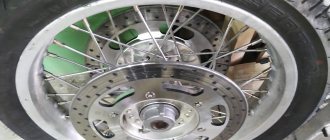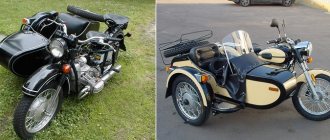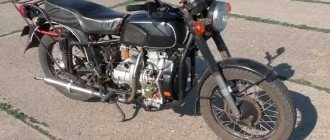The first popular favorite was made back in 1985. It was then that the first motorcycle, IZH Jupiter-5, rolled off the assembly line. Over the past almost three decades, it has not lost its relevance for motorcycle enthusiasts. Domestic bikers, for whom it is not enough just to buy a Harley-Davidson due to financial capabilities, are quite satisfied with the brainchild of the domestic motorcycle industry, especially since if you use skillful hands and a little effort, then with the help of tuning IZ Jupiter-5 you can make a motorcycle that, according to its technical characteristics, characteristics, if not superior to its overseas counterpart, then at least not inferior.
It’s much easier for owners of foreign brands, since they always have a motorcycle tuning catalog at hand, but the owners of “Yulia” have only one thing left to do - roll up their sleeves and start tuning IZH Jupiter-5 on their own, with their own hands, relying only on their own experience and technical possibilities.
Pipes, muffler for motorcycles IZH Jupiter, Planet 5
The engine of IZH motorcycles is two-stroke, so the fuel combustion process is noisier than a four-stroke engine, and a larger amount of unburned gases is also released into the atmosphere. At the moment of release, the exhaust gases have a high temperature that is dangerous to the health of the motorcyclist. Therefore, the IL muffler pipes must have a more complex design. Comply with safety standards and not cause harm to human health and the environment.
Change in appearance.
Despite the fact that the design of the fifth Planet model was probably the most interesting among all domestic motorcycles, tuning the IZH Planet - 5 motorcycle most often began with the appearance. The main reason for this was that work to change the external image can be classified as the simplest, not requiring deep technical knowledge and skills.
For this purpose, the following main work was carried out:
- double-sided arches and knee guards were installed;
- the windshield was replaced;
- higher wings were mounted;
- direction indicators were replaced;
- the muffler pipe was replaced;
- enlarged side mirrors were installed.
The principle of operation of the muffler
After fuel combustion in a small chamber, the gases have enormous energy and escape at high speed from the cylinder pipe into the pipe and then into the muffler. This is accompanied by a lot of noise. After passing through the labyrinths of the silencer, the energy wastes its strength. This causes all exhaust parts to heat up. This system not only performs the work of removing gases. By selecting the size and geometry of the muffler pipe, you can achieve fuel savings and increase the power of a two-stroke engine. The picture of the layout shows which part is responsible for what.
Improvement of technical parameters
Tuning to increase power.
The design of the motorcycle engine allows for tuning to increase its power. One option is to re-press the engine crankshaft and change the support bearings. Usually, secondary shaft bearings from a Java motorcycle were installed as new bearings. This restoration made it possible to achieve an increase in engine power of the IZH Planet - 5 by 10-15%.
The next option for adding power was to increase the cylinder volume. For this purpose, its upper part was cut off and the sleeve was bored to 76 mm. Then the appropriate piston was installed, usually a piston from a Planet Sport motorcycle was used.
Increasing the speed of the motorcycle.
After this operation, the speed of the motorcycle increased, according to some sources, to 160 km per hour. Therefore, work to increase engine capacity was carried out by owners who planned to operate their vehicle mainly on highways.
The most difficult technical tuning option for adding power to the IZH Planet - 5 is the installation of supercharging. For this purpose, an exhaust valve is installed, the device of which corresponds to the analogues on the sports versions.
Then an exhaust resonator is installed, which has sharply directed parameters. Its task is to create a wave backpressure of the fuel mixture. Next, a spool valve is installed to obtain asymmetrical phases of engine operation, which avoids the direct release of the spent mixture.
Performing supercharging on the engine of the Fifth Planet is a rather complex process and therefore is not widely used.
Improved grip.
As engine power increases, it is necessary to carry out work to improve the clutch. Under standard conditions, the standard clutch works reliably.
But as the load increases, the risk of “burning” it and subsequent repairs increases sharply. The main steps for tuning the clutch come down to replacing standard discs with larger metal ones. Typically, such discs are made of two millimeter iron.
The use of thicker metal discs reduces slippage, warping, breakage and provides greater heat transfer.
Causes of engine power loss
The first models of IZH motorcycles were equipped with easy-to-maintain mufflers. The advantage is complete disassembly. We began to notice a drop in power. First of all, pay attention to the exhaust system. Disassemble the muffler and give it a good cleaning. But soon they felt weak power again. Pay attention to the gap between acoustic filter 2 and partition 1. The lack of normal gap inhibits the exit of gases, which leads to a drop in power. The engine starts running intermittently.
Do-it-yourself IZH Jupiter-5 engine tuning
Almost all motorcycle owners begin their transformation with a muffler. Installed chrome “cans” can add solidity, but will “strangle” the engine. Therefore, with such an upgrade it will be necessary to change the intake. A correctly configured resonator, which has a separate muffling part, will allow the engine not only to “breathe” freely, but also, when operating at certain speeds, it will be able to provide pickup.
For “Jupiters”, in which the cubic capacity of each cylinder is 175 m 3, tuned resonators from motorcycles from the Kovrov plant are ideal. Here everything depends on your desire - if you want it to “shoot” at the top, then the resonator from the SMB-2 will suit you, the power in the “middle”, then the resonator from the ZiD-200.
Muffler cleaning methods
The exhaust system has no adjustments, therefore, it is necessary to clean it in a timely manner.
Filters that dampen sound must be removed and burned. You can do it over a fire or use a blowtorch. Cool quickly using cold water. This leads to carbon deposits peeling off. Clean the pipe with a metal brush.
The next method is to burn off the carbon deposits and remaining fuel inside. Let's place the pipe vertically, you need to set it on fire from below, a draft will appear and all the carbon inside will burn out. All that remains is to remove the combustion residues.
A gentle way to clean. Use a chemical solution to soften deposits. The solution is prepared for a liter of water, 25 grams of caustic soda, 33 grams of carbonic soda, 8.5 grams of soap. Heat the solution strongly until almost boiling. Pour it inside the muffler and wait a couple of hours. After this, rinse thoroughly with warm water.
Source
How to make a muffler for Izh Planet 5
The engines of Soviet (and not only) motorcycles are designed for certain average performance in order to ensure their service life and durability, so it is always possible to improve the motorcycle parameters that interest us. (see continuation)
The muffler cannot provide an increase in power over the entire rpm range. Plus, it is initially set to a mode that produces an increase in torque, not power. In this case, the wave of exhaust gases must have time to pass through the entire resonator, be reflected from the cone and return to the exhaust window at the moment when it is still open, and the purge windows have already closed. If the wave arrives earlier, it will drive part of the working mixture back into the purge channels. If later, part of the working mixture will have time to fly out of the exhaust pipe. In both cases, torque and power will decrease and fuel consumption will increase.
Resonator dimensions : L – total length of the resonator; L count – length of the muffler “elbow”; L p.c. – length of the front “straight” cone; L cf – length of the middle part; L obr.k. – length of the reverse cone; D count – diameter of the “knee”; D cf – diameter of the middle part; D jam. – diameter of the muffling part.
The most important dimension - L (total length of the exhaust system from the exhaust port to the end of the return cone) can be calculated using the formula:
L =[( a prod + avyp)/720 x 1/ n x 33,360]/2
where: aprod — purging phase (deg.); avyp — release phase (deg.); n — engine speed at which it is necessary to obtain an increase in torque (rpm); 33,360 m/min is the accepted average speed of the gas wave in the exhaust pipe. The volume of the resonator must be an even number of times greater than the working volume of the cylinder, that is, 2, 4, 6, etc. - only in this case will the muffler work as it should.
Specifications.
The serial Planet 5 had the following main characteristics:
- base – 1.45 m;
- frame – welded, tubular;
- dimensions;
- Length – 2.20 m,
- Width – 0.81 m,
- Height – 1.20 m,
- weight – 160 kg;
- maximum load – 175 kg;
- engine – two-stroke single-cylinder;
- cooling option – air;
- cylinder diameter – 72 mm;
- working volume – 345 cubic meters. cm
- engine power > – 22.0, hp;
- maximum speed – 120 km/h;
- fuel consumption – 5.0 l (90 km/h)
- mixture ratio of oil and gasoline (A 76) – 1/30;
- battery voltage – 12 volts;
- clutch - multi-disc;
- gearbox – four-speed.
These parameters and engine performance provided the motorcycle with high traction characteristics at low speeds, which allowed for confident movement, especially on rural roads.
Calculation and production of a resonator in reality 350 638
L=((118+164)/720*1/5250*3360)/2=1.24m = 1240mm
The length of the elbow should be within 20-28% of the total length of the exhaust system: (1240*28)/100 = 350mm The length of the straight cone should be 32-38%: (1240*32)/100 = 400mm The length of the middle part is accordingly 8 -10%: (1240*10)/100 = 120mm The length of the reverse cone is respectively 30-35%: (1240*30)/100 = 370mm The diameter of the elbow is 63-70% of the diameter of the cylinder, which is 58mm: (58* 65)/100 = 38mm , i.e. corresponds to the diameter of a standard JAVA elbow. The diameter of the muffling part is 65-75% of the diameter of the elbow, i.e. 25-28.5mm We will calculate the diameter of the middle part using the formula given in the article: 38+0.21*400 = 120mm
Making a resonator in real life 350 638
Dimensions of resonator parts designed for different speed ranges of the JAWA 638 motorcycle
Program for calculating resonators in Java, etc. download
1 way. A more labor-intensive method is to shorten the elbow according to its estimated length, and make the straight cone curved, dividing it into small cones. Photo of the resonator below:
Method 2. Less labor-intensive - we shorten the elbow so that a straight cone can be attached to it. Then we make several longitudinal cuts from the end of the knee to the place where the calculated knee should end.
The cut parts must be expanded so that they form the beginning of a straight cone. You will also have to cut “patches” to connect the cut parts. Photo of the resonator below:
You can scan metal using the setup-cone program. Download
Drawing of a resonator for Izh Jupiter/Planet motorcycles
(Jupiter is the average size, for the planet it is the maximum)
I read earlier on the Internet that the resonator for the P5 engine (one-pipe design) is very long and awkward.
Today at work during a smoke break I came across a program for Android (I use a tablet) to calculate the resonator for a 2T motor. The program contains four calculation methods - Grigoriev, Voitenko, Blair and complex. I calculated using a complex method.
I’ll say right away that the calculation is carried out according to the purge and exhaust phases. I have modified, seriously modified valve timing; these drawings will not work at all on a stock engine.
I wanted something like this: a resonator, but of short length, and maximum output at low speeds (3-4.5 thousand) because installing a huge pipe doesn’t fit the style, I don’t want to run it under the frame; I plan to use it not only on asphalt. I will say that my wishes regarding the short exhaust were dashed by calculations.
The main calculation for my engine is for 3 thousand revolutions. For 4 thousand I'll throw it lower
The resonator is calculated to add 8-17% power (compared to a standard exhaust). With the current configuration, the piston configuration produces 32 hp without a resonator and 34.5-38 hp with a resonator.
Help. What to do. The length of 2 meters does not suit me (counting is from the mirror of the cylinder). For reference, the standard length is 20 cm less. Optimal - 120-160 cm. The long exhaust kills the entire appearance. Can you tell me how and where to hide it?
Other entries in this logbook
Lowering and proper drainage
Hello friends! There won’t be a lot of writing) Yesterday I looked at the “tied” motorcycle and decided to “lower” the tail) But not by sawing etc. Read more
What's happening.
Greetings friends! Happy belated holidays to you! In all today’s photos you see the motorcycle in the position in which I’m sitting on it—simply. Read more
Chains or spikes? I was faced with a choice.
Good day, readers! The cold weather has set in and winter and snow are approaching (yeah, captain obvious, I know). Road grip becomes in. Read more
Comments
Only authorized users can leave comments
Rechitsa
I came across this post by accident. It's nice that someone is using my program. And yes, indeed, the lower the calculated speed, the longer the silencer is. And this is the real problem. I thought in reality that I wanted to get the engine to run efficiently at 4500 rpm. But the length is too long. But everywhere they recommend calculating the cutter at the speed at which the engine produces maximum power, and on my Java it’s 5200. Although I’m not sure I’m spinning that much. But when calculating for 5200, the length turns out to be at least sane. In your case, you can do as the guys in this video vk.com/rezkit?w=wall-32646518_202%2Fall Screw the resonator into a ram's horn. It will be more difficult to make, of course, but this is a compromise. If you think about it, you can do it beautifully.
SaviorBlack
Russia, Krasnodar
The program is really interesting. Partially helped in understanding and small calculations. But for the motor, not a classic half-wave resonator was made, but a quarter-wave one. The twist into the ram's horn did not suit me. I calculated it myself according to Blair, and made the sound dampening system ala “LeoVinci”. It is in subsequent posts)
How to make a forward flow on a motorcycle with your own hands?
How to make a forward flow on a motorcycle with your own hands?
Every self-respecting motorcyclist spends a lot of time and effort on improving his own machine. By increasing the engine's capabilities and improving the performance of the tank, attention eventually turns to the exhaust system. A brand new direct flow on a motorcycle, installed with your own hands, will delight the driver’s eyes and ears. The modernized exhaust system on motorcycles looks much more stylish and aesthetically pleasing, and the loud sound makes the bike noticeable on the road and helps to avoid unpleasant situations.
What is forward flow?
A cocurrent is a design for moving liquids and gases in a single direction. From the factory, the motorcycle comes with a standardized exhaust system, but subsequently customizing the bike and increasing its power from the original configuration is no longer enough - the amount of exhaust gases increases. Specialists install a direct-flow system, visually and technically improving your motorcycle (power will increase by 3 - 5 horsepower), but it is much more pleasant to do it yourself. This task will not require much time, the materials are quite accessible, all that remains is to arm yourself with information.
How to make a muffler for a motorcycle?
· Unscrew the mounting bolts and remove the old factory muffler.
· Pull out the standard internals - tubes and other offal.
· Buy a thin-walled tube or make it yourself from scrap garage materials. Stainless steel or aluminum without defects are the best option. Furrows, chips and holes will give the direct flow an unpleasant metallic noise, and incorrect tube dimensions will impede gas exhaust. Be careful when creating a muffler for a motorcycle with your own hands: maintenance requirements must not be violated.
· The outer shell of the muffler and the thin inner tube differ significantly in volume; it is recommended to tightly fill the gap between them with glass wool - this will help reduce noise. The risk of glass wool catching fire is minimized by wrapping the tube with a fire-resistant substance or asbestos.
· Using fasteners, we attach the muffler back to the motorcycle, cover the exhaust part with a lid and check the result of our manual work. When the bike starts, you should hear a slight bass tone. If you want more expressive effects in the sound of the forward flow, there is another way to create a muffler, which we will discuss later.
How to create a sonorous forward flow on a motorcycle with your own hands?
· There are a large number of varieties of forward flow: some enhance power, others improve sound, the third category of forward flow gives a double result.
· The essence of the work of high-quality direct flow is to manage gases and liquids in a motor-heat exchanger, directing the substances blocked by the wall in a single direction.
· Having conceived your own direct flow project, be sure to check out the videos of workshops posted online. If you have experience and engineering thinking, you can experiment and invent new types of direct flows.
· A welding machine and an angle grinder will help you make a unique muffler for a motorcycle with your own hands. To do this, we buy sheet stainless steel, roll it into a pipe, fastening the individual elements with argon arc welding. The inner tube is made in the same way, only with a smaller diameter, and many small holes are first drilled in the steel sheet. At the final stage, the end caps are attached.
· The further process is reminiscent of replacing the original muffler with a homemade one. They fill it with glass wool and cover it with asbestos. It is necessary to fill the space between the shell and the tube more tightly, then vibration and noise during driving will be less.
· Some specialists convert car mufflers to motorcycle ones, how do they do this and what does it give? The only difference is the excellent motorcycle and auto mounts, which can be corrected with a welding machine. The seams are covered with chrome paint. The output is a stylish, velvety direct-flow sound and increased power levels. A pleasant bonus is job satisfaction and tangible cost savings.
Source
Tags: homemade silencer Planet 5
Comments 29
and what about the sound, where is the video?!
yes there is no video, the sound is a little clearer than the original and louder)
no offense, but this guy's look is just terrible
Well, what if it’s already 20 years old, your friend wants to convert it into a chopper in the spring, I’ll help, post photos as soon as possible
so Kent and I collected from a pile of garbage! =)) we got into our hands a frame on wheels, a rusty tank and a motor in a bag without a cylinder and a shaft elbow =)))
Well, I was the first to watch it)
Damn, I’m wondering why and when I signed up for this amazing thing =)))
plus to my colleagues. The resonator at 2T is an important thing and needs to be calculated.
except for the appearance - natural stupidity. In old motorcycle magazines, I don’t remember the number, there was an article about calculating the resonator of a two-stroke bike, I advise you to look for this article.
on the 5th planet, the welded resonator should ideally be 1.5 meters long) but how to put it there is another question, so you shouldn’t touch it, it was a drain plug)
Yes, it's just a change in appearance and nothing more, my friend said I did it. I plan to bring the resonator to the top in Minsk like on a cross-country, we’ll think about it there!
there is no traction there, read the theory of a 2-stroke engine
I agree, a 2-stroke motor needs a tuned resonator, which is designed for a specific motor. Even the native P5 had more or less... What is the current consumption?)))










